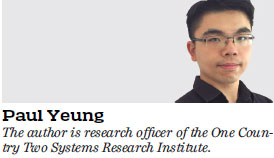Greater Bay Area now a key factor in'Hong Kong 2030+'
Updated: 2017-04-28 07:00
By Paul Yeung(HK Edition)
|
|||||||
Can you imagine the development of Hong Kong after 2030? The six-month public engagement for "Hong Kong 2030+: Towards a Planning Vision and Strategy Transcending 2030" is coming to an end this month. It's time for us to think and discuss this crucial issue with a far-sighted mindset.
What will Hong Kong look like in 20 years' time? This question may be too distant to most of us but not to the planning authority. Indeed, strategic planning has been a regular practice in Hong Kong for many years. Since the 1970s, the government would review the regional development strategy every decade. For instance, "Hong Kong 2030", the last long-term strategic plan for spatial development, was promulgated in 2007. This time, "Hong Kong 2030+" will be a comprehensive study to update the planning strategy based on the foundations of "Hong Kong 2030" and review the spatial development directions beyond 2030 in the light of the dynamics and changing circumstances in the future.
"2030+" is crucial to all of us living in Hong Kong. The major socio-economic problems Hong Kong faces nowadays are, to a certain extent, related to the previous planning strategies adopted decades ago. That means what we plan today will be significant to our future, even though we may not yet know exactly how it will affect our future. To think through this issue, we can employ two simple approaches: "looking back" and "looking forward".

Let's look back first. The history of Hong Kong's development is closely linked to land development. In the 1960s to 1980s development of new towns such as Sha Tin, Tuen Mun and Tsuen Wan provided more than 10,000 hectares of land and contributed to the industrial, economic and social development of Hong Kong. From 1995 to 2004, the total area of developed land in Hong Kong increased by 7,800 hectares. The increment, however, dropped significantly to 1,100 hectares during 2005-14, which implies we are running out of land resources. The resultant land shortage has constrained the solutions to many problems such as high housing costs, lack of social facilities and a monotonous industrial structure. We now realize that a large land reserve is key to sustainable development in both the social and economic aspects.
The issue not only concerns land development but also the model. Hong Kong's development is constrained by an old urban planning problem - economic activities concentrated on a condensed and over-crowded central business district (CBD). On the one hand, most important economic activities are packed alongside Victoria Harbour; on the other hand, there are too few jobs available in the new towns. This uneven spatial design has led to extremely high land costs in the CBD and development barriers in the new towns such as Tin Shui Wai. Moreover, the residents in remote new town areas have to travel to the CBD to work, resulting in a heavy burden on the transport system.
Maybe by looking back we can see the problems, but by looking forward we can find out opportunities and solutions. The development of the Guangdong-Hong Kong-Macao Greater Bay Area was mentioned in Premier Li Keqiang's annual work report for the first time, which means the plan has been elevated from a regional level to a national strategic level. The idea of developing a city cluster provides a golden opportunity for Hong Kong's future development. The "2030+" should also explore the future role of Hong Kong in the Greater Bay Area. For instance, the area's governments will further foster greater economic cooperation and infrastructure development in the city cluster involving Hong Kong, Macao and nine Guangdong cities. The idea of "one-hour living circle" will be more practical.
Given the emergence of the new factor - Greater Bay Area development - we should rethink Hong Kong's future spatial design. In the consultation paper of "Hong Kong 2030+", the government proposed a conceptual spatial development framework which features a metropolitan business core and two strategic growth areas. The two strategic growth areas are East Lantau Metropolis and New Territories North. There is a new and ambitious idea which suggests upgrading the two growth areas to two sub-CBDs with a significant economic role. One sub-CBD is Lantau Island, including the East Lantau Metropolis, and another one is the New Territories North (including Hung Shui Kiu New Development Area). These two sub-CBDs are expected to facilitate development of new industries and provide more room for a livable Hong Kong and sustainable development.
The idea of sub-CBD may be crucial to the future development of Hong Kong. However, further public discussion is needed before it can be finalized. Laozi's wisdom teaches us, "A journey of 1,000 miles begins with a single step". Let's start by sending our views on "Hong Kong 2030+" to the authority by April 30 and further have more constructive discussions on the city's future spatial design.
(HK Edition 04/28/2017 page1)